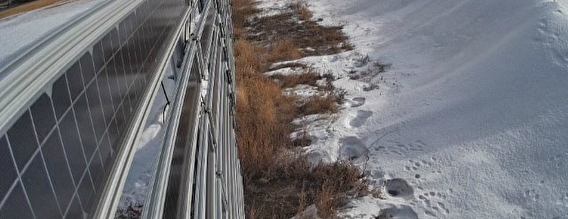
Snow fences are an important tool for reducing blowing snow and ice on winter roads, and researchers are looking to offset the installation cost by having them pull double-duty as solar energy generators.
The solar snow fence project is a collaboration between the Minnesota Department of Transportation (MnDOT) and North Dakota State University (NDSU). MnDOT funded the project with the aim of potentially using solar snow fences along Minnesota roads if cost-effective.
In 2021, Mijia Yang, professor with NDSU’s Department of Civil, Construction, and Environmental Engineering and project principal investigator, led a research team in a preliminary study to gauge the viability of the solar snow fence concept. Team members conducted surveys to determine public opinion, designed a prototype system in a lab, and ran preliminary cost-benefit analyses.
Since the project has progressed to field testing, Yang presented an update on the work at the 2024 Salt Symposium, which was held August 6 and 7 and sponsored by Bolton & Menk.
Yang’s team set up 100 feet of prototype fencing alongside a highway near Glyndon, Minnesota. The metal posts supporting the structure stand eight feet tall, and the solar panels are mounted horizontally on aluminum rails. To track how the system performs in different environmental conditions, the researchers outfitted the fence with cameras and other monitoring equipment.
The system collects solar energy from 8 a.m. to 4 p.m. During that period, it can produce between 16 and 25 kilowatt-hours per day (depending on cloud cover). This was enough power to run the monitoring equipment plus some heating pads set up near the control booth to melt snow. Overall, Yang said, the system generates enough energy to supply daily power needs to a middle-sized family.
There are numerous up-front costs to the solar fence, including the cost of the fence itself, labor, permitting, operation, and maintenance. However, these costs can be recouped in a number of ways. The solar energy can be either used directly or sold to utility companies. Solar installations can also potentially count towards federal, state, and local government incentive programs (such as the federal Investment Tax Credit or renewable energy certificates).
After conducting an updated cost-benefit analysis, Yang’s research team determined that the most cost-efficient ownership model is a power purchase agreement, wherein a third-party developer owns, installs, and operates the solar equipment.
The researchers also determined that solar fences benefit from an economy of scale; 100 feet of fencing costs around $22,000 to install, Yang said, and it can pay for itself in approximately 11 years. With a one-mile installation, that break-even point can be reached in around five years.
Moving forward, Yang and his team are interested in exploring different applications of the power generated by the fences—for example, powering Minnesota rest areas, which are usually remote and difficult to deliver power to. The team is also testing whether the fences can power greenhouses.
—Sophie Koch, contributing writer